RML 12-inch 25-ton gun facts for kids
Quick facts for kids Ordnance RML 12-inch 25-ton gun |
|
|---|---|

A 12-inch (305 mm) 25-ton gun in an armoured turret aboard the ram HMS Hotspur. A shell is suspended near the muzzle ready for loading.
|
|
| Type | Naval gun Coast defence gun |
| Service history | |
| Used by | Royal Navy |
| Production history | |
| Designed | 1864–1866 |
| Manufacturer | Royal Arsenal |
| Unit cost | £1,716 |
| Produced | 1866 – 187? |
| Variants | Mk I, Mk II |
| Specifications | |
| Mass | Mk I : 23.5 long tons (23,900 kg) Mk II : 25 long tons (25,000 kg) |
| Barrel length | 145 inches (3.7 m) (bore + chamber) |
|
|
|
| Shell | 600 to 608.4 pounds (272.2 to 276.0 kg) (Palliser) 497 pounds (225.4 kg) (Common & Shrapnel) |
| Calibre | 12-inch (304.8 mm) |
| Muzzle velocity | 1,300 feet per second (400 m/s) |
The RML 12-inch 25-ton gun was a huge cannon used by the British Navy in the late 1800s. These powerful guns were the main weapons on large warships called ironclad battleships and coastal monitors. They were also used on land to protect the coast. This 25-ton gun was one of two types of 12-inch (305 mm) guns, being a bit smaller and less powerful than the 35-ton version.
Contents
Gun Design
These guns were "rifled muzzle-loaders." This means they had spiral grooves inside the barrel (rifling) to make the shell spin, which helped it fly straight. They were loaded from the front (muzzle).
Mark I Guns
The first four guns were made in 1866. They had a strong steel tube wrapped with many layers of wrought iron coils. This design was based on an older method by a man named Armstrong.
Mark II Guns
While the Mark I guns were strong, making them with so many coils was very expensive. So, starting in 1867, a simpler and cheaper way was used, called the "Fraser" system. This system used fewer, but larger, coils.
However, these Mark II guns were not considered very successful. The way the rifling twisted inside the barrel (from 1 in 100 to 1 in 50) wasn't enough to make the shells fly accurately. Because of this, when the inside of the gun barrels wore out, they were often replaced with new barrels that were 11 inches (279 mm) wide instead of 12 inches.
These powerful guns were put on several British warships:
- HMS Captain (1869): 4 guns
- HMS Monarch (1868): 4 guns
- HMS Hotspur (1870): 2 guns
- HMS Glatton (1871): 2 guns
- HMS Belleisle (1876): 4 guns
- HMS Orion (1879): 4 guns
Ammunition
When these guns were first used, their shells had small "studs" on them. These studs fit into the rifling grooves inside the gun barrel, making the shell spin as it was fired.
Later, special "gas-checks" were added to the back of the studded shells. These helped reduce how much the gun wore out and made the shells fly farther and more accurately. Even newer "automatic gas-checks" were then created. These could make shells spin even without studs, allowing for new types of ammunition. So, these guns could use both old studded shells and newer studless ones.
The main type of shell used was the "Palliser" armour-piercing shot. It weighed between 600 and 608 pounds (272 to 275 kilograms). To fire it with the most power, an 85-pound (38.5 kg) "Battering charge" of gunpowder was used.
Other shells included "Shrapnel" (which exploded to scatter many small pieces) and "Common" (exploding) shells. These weighed 497 pounds (225.5 kilograms). They were fired with a "Full charge" of 55 pounds (25 kg) of gunpowder.
See also
- List of naval guns
Surviving Examples
- A surviving gun at Drake's Island, Plymouth, UK
Images for kids




